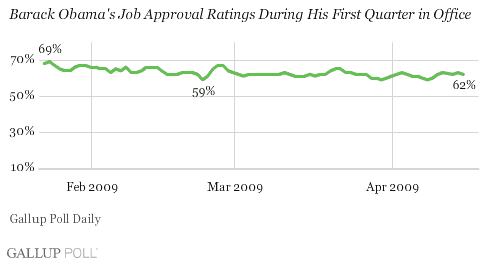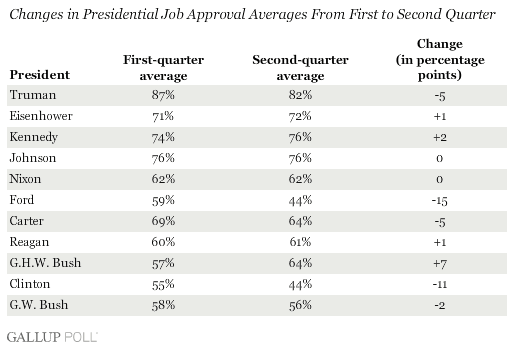PRINCETON, NJ -- Barack Obama's first quarter in office concludes on Sunday, and during this early stage of his presidency he has averaged a solid 63% job approval, reaching as high as 69% in the initial days of his presidency and falling as low as 59% on a few occasions.

Obama's 63% first-quarter average matches the historical average of 63% for elected presidents' first quarters since 1953. However, it is the fourth highest for a newly elected president since that time, and the highest since Jimmy Carter's 69% in 1977. The historical first-quarter average includes two presidents whose scores exceeded 70% (John Kennedy's 74% and Dwight Eisenhower's 71%).

The average for all presidents' first quarters since World War II -- both presidents who were elected and those who took office after the death or resignation of their predecessors -- is slightly higher, at 66%. Harry Truman (87%) and Lyndon Johnson (76%) are two presidents who came into office mid-term and had very high initial approval ratings.
From a broader historical perspective, Obama's 63% quarterly average is well above the historical norm for all approval ratings, regardless of presidential quarter. It ranks in the 74th percentile of all presidential quarters since 1945, and is significantly better than the 54% average rating for all presidential quarters.
Looking Ahead
Obama's job approval rating has not shown much variation to date, generally holding steady in the low 60% range. While such presidential "honeymoons" do not last forever, to the extent history is a guide, Obama's healthy ratings can be expected to persist for at least another quarter.
Six of the last 11 presidents saw essentially no change in their approval ratings from the first to the second quarter in office. The ones who did see significant movement tended to start out with ratings that were higher (Truman and Carter) or lower (George H.W. Bush) than the norm.

Gerald Ford and Bill Clinton both saw rather abrupt ends to their honeymoons. Ford's controversial pardon of Nixon sent his approval ratings plummeting. An early September 1974 poll (conducted mostly before Ford pardoned Nixon on Sept. 8) measured a 66% approval rating for Ford. By the next poll, Ford's approval rating was down to 50%, and continued declining thereafter.
Clinton's 55% first-quarter average is the lowest for a recent president, and, after a number of controversial actions, his approval rating sank to 44% in his second quarter in office.
There is not a typical pattern as to when honeymoons end. Several presidents who did not show declining approval ratings in their second quarter in office did so by their third quarter, but others' ratings held steady for the better part of their first year. Still others, including both Bushes, saw increases in their approval ratings after international crises.
Implications
President Obama is off to a solid start as president, as far as his job approval ratings are concerned. His 63% first-quarter average is the better than the averages of each of his four predecessors, and the fourth best since 1953. Perhaps the biggest legislative accomplishment of his first quarter has been the passage of the economic stimulus bill. In the second quarter, Congress will likely begin work in earnest on his proposed budget. How that process plays out, whether the economy shows definite signs of improvement, and how well Obama deals with ongoing international challenges, will determine whether his ratings stay strong or begin to show decline.
Survey Methods
Results are based on aggregated telephone interviews with approximately 500 national adults, aged 18 and older, conducted each day from Jan. 21-April 15, 2009, as part of Gallup Poll Daily tracking. For results based on the total sample of national adults, one can say with 95% confidence that the maximum margin of sampling error is ±3 percentage points.
Interviews are conducted with respondents on land-line telephones (for respondents with a land-line telephone) and cellular phones (for respondents who are cell-phone only).
In addition to sampling error, question wording and practical difficulties in conducting surveys can introduce error or bias into the findings of public opinion polls.
